Update:
I gave David Weinstein, the founder of Rivertown (now at Apellis Pharmaceuticals), a call to talk about what happened at Rivertown. He’s a very genial and talkative fellow and was happy to answer my questions and very enjoyable to discuss this with. (we ended up going on a long tangent discussing rapamycin).
He said the key issue was that it is very hard to get funding around a combination product (with generic drugs as key parts of the combination) in the cosmeceutical market space. I suspect that behind this may be the issue of how defensible any patent would be in this area, and of course the cost of large clinical trials is very significant to get FDA approval.
He said there is ongoing research with these compounds he is involved in (he is the PI) at the University Alabama which is also focused on hair color reversal, and he remains very confident about the results of this formulation.
David said that they had tested it with 40 to 50 people during the course of his efforts with Rivertown the past few years, and there were very high rates of efficacy. Anytime you stimulate the renewed hair cycle he said, you will get return of the hair color. Only if you have had a completely bald head for a significant period of time does he think it will not work at all.
The medical name for the process of hair going gray is, David informed me, achromotrichia. Put simply, ‘achromotrichia’ is defined as the absence or loss of pigmentation in the hair.
I discussed with David Weinstein the differences between the compound which he had identified in the lab (which only later did he discover had also been identified by Guilford Pharmaceuticals independently) and tacrolimus.
Tacrolimus, he said is very similar to GPI 1485 (GPI 1485 is actually derived of tacrolimus), but GPI 1485 is not an immunosuppressant. David said he was apprehensive around the idea of ongoing use of an immunosupressant even in topical form. (though in the study of topical rapamycin cream for skin aging, there was no systemic take-up of topically applied rapamycin, so I think his concern may be overblown).
David commented on how the research behind GPI 1485 (and what he saw) is that its very effective in increasing speed of wound healing. He commented on how tacrolimus, as an immunosuppressant, likely slows wound healing. So, he suggested while tacrolimus may have some of the same effects as GPI 1485, it also has some risks and downsides. So, in an ideal world, you probably want to use GPI 1485, if you can get it.
For people looking for this chemical, here are the identifiers:
GPI-1485
CAS No. : 186268-78-0
More on the molecule:
And David Weinstein’s research that led him, accidentally, to the hair formulation:
